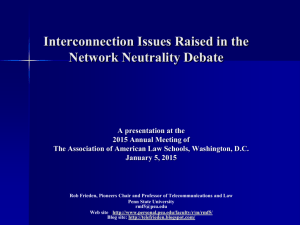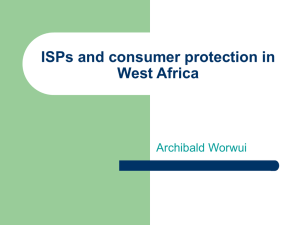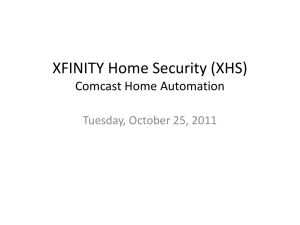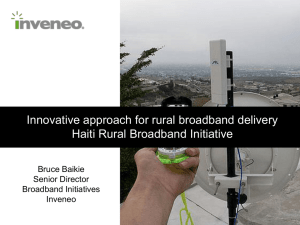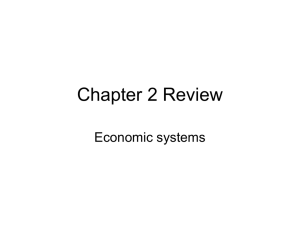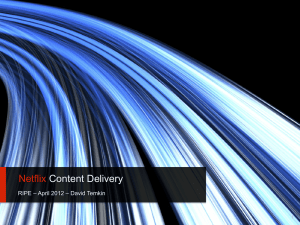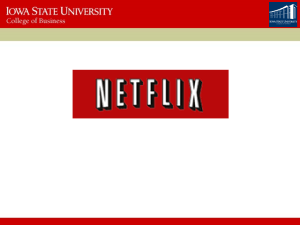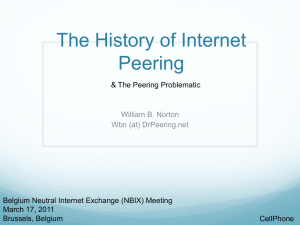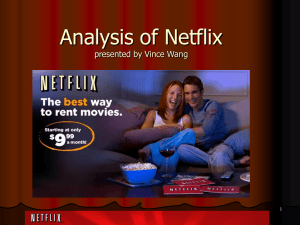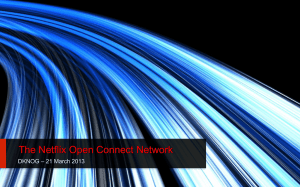Analogies Used to Explain How the Internet Works
advertisement
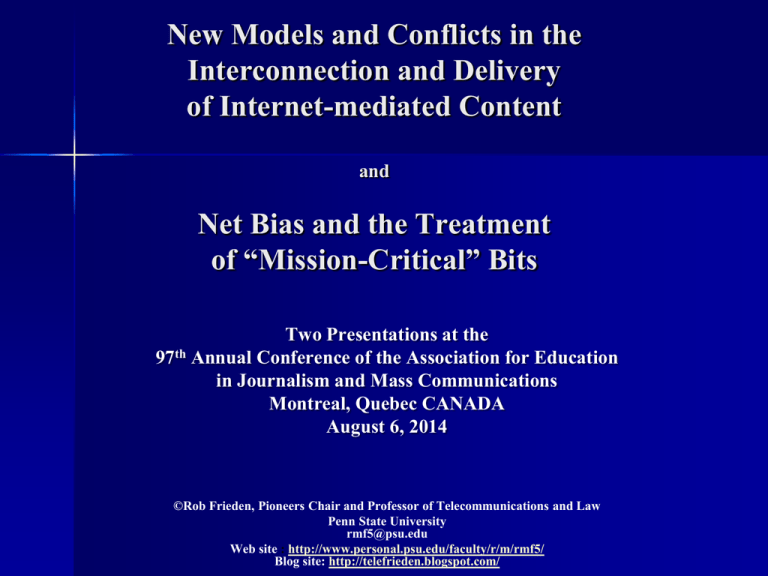
New Models and Conflicts in the Interconnection and Delivery of Internet-mediated Content and Net Bias and the Treatment of “Mission-Critical” Bits Two Presentations at the 97th Annual Conference of the Association for Education in Journalism and Mass Communications Montreal, Quebec CANADA August 6, 2014 ©Rob Frieden, Pioneers Chair and Professor of Telecommunications and Law Penn State University rmf5@psu.edu Web site : http://www.personal.psu.edu/faculty/r/m/rmf5/ Blog site: http://telefrieden.blogspot.com/ Analogies Used to Explain How the Internet Works Several analogies and models provide a frame of reference for understanding how the Internet works. It’s a cloud: It’s a network of networks: 2 Analogies Used to Explain How the Internet Works It’s a series of tubes: It’s part of a broadband communications supply chain: 3 Analogies Used to Explain How the Internet Works It’s a hierarchy of protocols: 4 Four Phases in Internet Development 1) Incubation--government as anchor tenant and underwriter, first through the United States Defense Department and later through the United States National Science Foundation along with research institutes throughout the world (1980s-1995); 2) Privatization--governments eliminate financial subsidies obligating contractors to assess whether and how to operate commercially (1995-1998); 3) Commercialization—private networks proliferate as do ventures creating software applications and content that traverse the Internet. The “dotcom boom” triggers irrational, excessive investment and overcapacity (19982001); and 4) Diversification—after the dotcom bust and market re-entrenchment, Internet survivors and market entrants expand the array of available services and ISPs offer diversified terms, conditions and rates, including price and quality of service discrimination needed by “mission critical” traffic having high bandwidth requirements, e.g., full motion video content. ISPs and even content providers can use deep packet inspection to identify traffic for “better than best efforts” routing and other forms of prioritization at one extreme and blockage/throttling at the other. 5 The Internet Ecosystem Consider the Internet as the product of seamless interconnection between servers, routers and broadband subscribers using the telecommunications transmission networks of many, often-unaffiliated operators. We should concentrate on the interconnection between various operators that go by several different names: Internet Service Provider (Tier-1, Tier-2, retail) Content Distribution Network, Peer, Paid Peer, Transit Lessee, etc. Source: George Ou, http://www.digitalsociety.org/2009/11/fcc-nprm-ban-on-paid-peering-harms-new-innovators/ 6 Source: George Ou, Digital Society, http://www.digitalsociety.org/2010/12/division-of-laborbetween-broadband-and-cdn/ 7 Many Interconnection Models Work in the Current Phase Until its privatization and commercialization, the Internet carriers typically used a zero charge, “peering” process that assumed a “rough justice” balance of traffic; even if traffic flows weren’t equal, governments rather than the carriers usually paid. Carriers operating in the now fully commercialized Internet pay close attention to traffic flows and now limit peering (barter) to equals in terms of bandwidth capacity, locations served, subscriber population, etc. Smaller ISPs now pay for “transit.” Substantial increase in downstream traffic handed off to retail ISPs triggered by IPTV/OTT and end user demand for access anytime, anywhere, via any device and in any presentation format; the end of “appointment television” with content delivery to at least 4 different screens (TV, PC, smartphone and tablet). As the nature and type of ISPs proliferate, so have interconnection models; for example Content Distribution Networks have lots of traffic to deliver downstream, and possibly very little to handle upstream. Traffic imbalances can trigger interconnection and compensation disputes, e.g., CogentComcast; Netflix-Comcast; Netflix-Verizon and Level 3-Comcast. 8 Many Interconnection Models Work in the Current Phase ISPs consider price and QOS discrimination essential for generating new profit centers; the Internet largely shifts from “best efforts,” “one size fits all” into a largely differentiated medium. New alternatives to the peering/transiting dichotomy including use of Internet Exchange Points by Tier-2 ISPs, paid peering (Comcast-Netflix), CDN surcharges (Level 3-Comcast), equipment co-location, e.g., Netflix Open Connect Network; “specialized networks” and Intranets; Multiprotocol Label Switching and non-carriers like Google securing Autonomous System identifiers. Content providers increasingly trade off maximum market penetration for smaller shares of paying customers; without firewalls and effective authentication, premium content won’t be offered. Even end users want “better than best efforts” routing of “mission critical” bitstreams, e.g., movies, pay per view, live, full motion video. 9 New Incentives Risk Network Balkanization and Challenges to the Goal of Ubiquitous Access Level 3-Comcast Dispute In late 2010 Comcast imposed a traffic delivery surcharge when Level 3 became the primary CDN for Netflix in the U.S. Level 3 characterized the surcharge as a discriminatory toll while Comcast framed the matter as a commercial peering dispute. Comcast is correct if one narrowly focuses on downstream traffic termination. But more broadly the dispute raises questions about the scope of duties Comcast owes its broadband subscribers and whether Level 3 is entitled to a good faith effort by Comcast to abate the traffic imbalances with upstream traffic. It also raises questions about the flow of compensation due participating carriers downstream from sources with which retail ISPs do not directly interconnect. 10 Misconceptions (or Misrepresentations) in the Level 3-Comcast Dispute Retail ISPs providing the “last mile” delivery of traffic do not directly receive compensation from upstream sources of content such as Google, Netflix, YouTube and Hulu. The peering process traditionally involves directly interconnecting carriers. This means Netflix has the responsibility of securing the services of a CDN, such as Level 3, but Level 3 bears the direct interconnection burden with retail ISPs such as Comcast. It is untrue to assert that hyper giant sources of traffic, do not pay for delivery of their content. Comcast enjoys the ability to charge twice in what economists term a double-sided market: 1) monthly retail broadband subscriptions, now tiered by transmission speed and amount of content downloaded monthly; and 2) peering/transit with upstream ISPs and CDNs such as Level 3. Note that Comcast successfully imposed a surcharge on its peering partner Level-3 when Netflix traffic upset the balance of traffic flows. 11 Providing Better Than Best Efforts Content Delivery via Proxy Servers Does Not Violate Open Internet Policy 12 Case Study: Victoria’s Secret Webcast 13 Consumers Want Conduit Neutrality Except When They Do Not Most consumers favor Internet Service Provider (“ISP”) neutrality and the application of “best efforts” routing protocols. In the absence of congestion, the status quo provides a level competitive playing field between content providers and distributors in terms of “access to eyeballs.” New bandwidth intensive applications, such as IPTV and OTT increase the probability of congestion and degradation of service quality, even in the absence of deliberate efforts by an ISP to “throttle” bandwidth hogging subscribers, or to disadvantage competitors. IPTV consumers have a quick pain threshold for QOS degradation; full motion video cannot become a slide show, or lose packets. IPTV consumers welcome QOS enhancements, including ones that offer “better than best efforts” prioritization of “mission critical” bitstreams, e.g., “live” programming such as sporting events and award telecasts. Companies, such as Akamai, Limelight Networks and Level 3, have generated no controversy when they enhance traffic delivery from the Internet cloud to the “retail” ISP for final delivery. The debate has focused on the “last mile.” 14 ISPs Want to Offer Paid Prioritization ISPs’ largely unregulated status promotes innovative ways to accommodate mission critical bits, but QOS and price discrimination can become a readily available way to favor corporate affiliates and ventures willing and able to pay surcharges. Many ISP parents face revenue challenges, e.g., Verizon and the decline in demand for wired telephony; Comcast and the decline in demand for cable television. Retail ISPs provide an exclusive, last mile conduit, because consumers typically chose only one carrier to provide all access to and from the Internet cloud. The FCC asks whether this a “terminating monopoly.” Last mile access competition remains limited: 1 DSL/hybrid fiber-coax carrier, 1 cable modem carrier. Satellite options are slower, more expensive and have latency (signal delay) challenges. 4th Generation terrestrial wireless offers a more expensive and still comparatively slower option and have significant caps on usage; consider the impact of a 5-10 Gigabyte monthly wireless allowance vs. an “unlimited” or 250 Gigabyte wireline allowance. Opponents of paid prioritization expect ISPs to nudge, or push content and application providers to better than best efforts service tiers by generating artificial congestion from standard service. ISPs can target individual ventures and bitstreams for QOS problems and consumers may not know whom to blame. 15 More Likelihood for Traffic Imbalances and Compensation Disputes Retail ISPs no longer will simply accommodate ever increasing downloading volumes. They have imposed rate increases on both sides of their market: downstream by tiering retail service based on bit delivery speeds and monthly downloading allotments and by targeting upstream ISPs and even content sources for surcharges. Some economists have tried to prove that when operating in a double-sided market a venture cannot extract two monopoly rents without harming profitability, but it remains unclear whether ISPs are so constrained. Unclear whether a startup venture with a tiny fraction of Netflix’s traffic volume can still relay on “plain vanilla” best efforts routing. As retail ISPs seek greater compensation, subscribers may wonder what their $4075 subscriber guarantees. Can one lawfully expect high QOS delivery of Netflix traffic, or is this outcome contingent on increasingly probable surcharge demands? 16 Netflix-Comcast Once an advocate for network neutrality, Netflix has opted for higher QOS through a paid peering arrangement with Comcast. Netflix directly interconnects with Comcast at many locations thereby reducing the number of networks and routers typically used. Virtually overnight Netflix traffic congestion problems evaporated thanks to lower latency and faster delivery speeds. Paid peering provides “Most Favored Nation” treatment of specific traffic streams has triggered a vigorous debate over what constitutes reasonable price and QOS discrimination. Netflix’s payments to Comcast are offset in part by reduced or eliminated payments to CDNs, but the accrual of more revenues for retail ISPs raises concerns about rising bottleneck/last mile control. Will surcharge demands and better than best efforts become the new normal even for venture with modest traffic volumes previously accommodated by the standard best efforts model? 17 Consequences of the Netflix-Comcast Deal Pressure to Upgrade--More better than best efforts routing options with the possible risk that content sources with far less volumes than Netflix might face severe pressure to migrate from standard, “best efforts” delivery. Higher Broadband Profit Margins--Broadband rate increases through tiering transmission bit rate and download allotments. Likely substantial narrowing in the gap between wireline (200 or more Gbytes) and wireless (250 Mbytes to 10 Gbytes). More Subscriber Options for Avoiding Download Debits--ISPs will “soften the blow” of stingy download caps with expanded opportunities for “sponsored data” by content and service providers who pay the retail ISP in lieu of it metering the download. ISPs Demand More Incentives to Upgrade--ISPs will leverage network upgrades in exchange for better interconnection terms with content providers, CDNs and upstream carriers. More Interconnection Compensation Disputes—Lots of finger pointing when QOS declines. Was Netflix to blame when it made the entire 2d season of House of Cards available, or was it cheapskate CDNs, or something nefarious at the last mile? 18 Lessons From Television Retransmission Disputes Television broadcasters and cable television operators negotiate for the latter’s right to deliver signals to subscribers. Broadcasters can secure mandatory carriage (“must carry”) at zero cost to cable operators; otherwise payments flow from cable operator to broadcaster for retransmission consent. Compensation in the U.S. has skyrocketed from $28 million in 2005 to $2.4 billion in 2012, a nearly 8,600 percent increase in seven years. The total is expect to more than double to $6.05 billion by 2018 amounting to about 23% of total TV station revenue. With increasing frequency, retransmission negotiations do not reach closure before a cable or DBS operator has to stop carrying specific channels. Consumer pain tolerance grows acute over days or weeks as opposed to minutes for broadband. For added leverage in negotiations the Fox and CBS networks identified cable television subscribers seeking access to blocked content available via the Hulu and CBS web sites. Fox denied Cablevision subscribers access and instead sent this message: CBS and Fox show net bias opportunities can exist far upstream from the last mile. 19 Similarities and Differences The Good News: Commercial negotiations can resolve most disputes with limited, if any harm to consumers and without regulator intervention. Netflix may have buyers remorse, but it negotiated for, and received what it needed for itself and its subscribers. Cable operators capitulate at the start of the regular NFL season so subscribers do not miss truly “must see” television. The Bad News: Broadband access has become a near essential. Any access dispute resulting in network balkanization, or blockage can cause significant and immediate harm to consumers. Commercial negotiations typically end up in yet higher cable television and broadband subscription rates. If broadband has become a necessity, rates will continue to increase, absent government-mandated subsidization. In both instances most national regulators lack direct statutory authority to intervene, only to provide benchmarks for what constitutes “good faith” negotiation. In the U.S. the FCC wisely refrains from interfering, but when, if ever, should it do so? Consumers can survive if Comcast relegates an unaffiliated sport channel (covering tennis) to a more expensive and less viewed programming tier than an affiliated sport channel (covering golf). The stakes and impact are much greater when a biased Internet favors certain types of content sources based of corporate affiliation, or ability to pay a surcharge. 20 Developing Trends The FCC and other national regulatory authorities (“NRAs”) will continue to struggle to find a lawful way to impose ground rules on ISP interconnection and compensation arrangements. NRAs will try to rely on commercial negotiations, but also may impose transparency, truth in billing and reporting requirements, especially for better than best efforts, specialized arrangements. NRAs may use a complaint resolution process to address disputes. Consumers can expect to pay more for both content and delivery services. ISPs appear to have solidified their control over the Internet ecosystem, despite the conventional wisdom that content rules. When content demand triggers congestion, the content provider and its subscribers end up paying more. ISPs will frame content prioritization as a necessary to manage a scarce resource, while opponents will accuse ISPs of creating scarcity and rationing a resource that previously managed to deliver content without surcharge or congestion. Increasing advocacy for reclassification of Internet access as a public utility, common carrier service. In the U.S. such advocacy will not achieve success and even if it did, common carriage only prohibits “unreasonable” discrimination. ISPs could offer paid traffic prioritization, provided it’s available to all “similarly situated” carriers and content providers. 21
